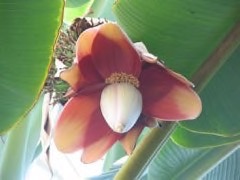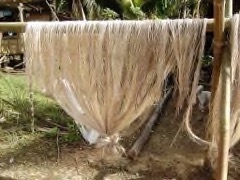 |
|
Wikimedia.org |
 |
| Jürgen Steger, Sachsenleinen GmbH wikimedia.org |
Translate this page:
Summary
Musa textilis or commonly known as Abaca is a banana species native to the Philippines and is mainly cultivated for its fiber. It is evergreen and perennial, and grows about 4 - 6 m in height with a clump of large pseudo stems that can be up to 30 cm in diameter. It produces runners along the ground that take roots at each segment to form new plants. The leaves are dark green but light green on the the underside and oblong. The fruits are inedible containing irregular shaped seeds. Abaca fiber or commonly known as Manila hemp is the strongest of the natural fibers. It is highly durable and resistant to salt water damage. It is used in the paper industry and in handcrafts like bags, carpets, furniture, and clothing.
Physical Characteristics

 Musa textilis is an evergreen Perennial growing to 3 m (9ft) by 3 m (9ft) at a fast rate.
Musa textilis is an evergreen Perennial growing to 3 m (9ft) by 3 m (9ft) at a fast rate.
See above for USDA hardiness. It is hardy to UK zone 10. The flowers are pollinated by Birds, Bats.
It is noted for attracting wildlife.
Suitable for: light (sandy), medium (loamy) and heavy (clay) soils and prefers well-drained soil. Suitable pH: mildly acid, neutral and basic (mildly alkaline) soils and can grow in very acid soils.
It cannot grow in the shade. It prefers moist soil. The plant is not wind tolerant.
UK Hardiness Map
US Hardiness Map
Synonyms
Musa abaca Perr. Musa amboinensis Miq. Musa mindanaensis Miq. Musa tikap Warb. Musa troglodytarum te
Plant Habitats
Edible Uses
References More on Edible Uses
Medicinal Uses
Plants For A Future can not take any responsibility for any adverse effects from the use of plants. Always seek advice from a professional before using a plant medicinally.
None known
References More on Medicinal Uses
The Bookshop: Edible Plant Books
Our Latest books on Perennial Plants For Food Forests and Permaculture Gardens in paperback or digital formats.

Edible Tropical Plants
Food Forest Plants for Hotter Conditions: 250+ Plants For Tropical Food Forests & Permaculture Gardens.
More

Edible Temperate Plants
Plants for Your Food Forest: 500 Plants for Temperate Food Forests & Permaculture Gardens.
More

More Books
PFAF have eight books available in paperback and digital formats. Browse the shop for more information.
Shop Now
Other Uses
Fibre Paper String
Other Uses The sclerenchym fibres of the leaf sheaths are used to make ropes for ships and nets that are resistant to salt-water[317 ]. The fibre is also used to make sacks, cloth etc[46 , 317 ]. In Japan it is used for making special paper for the construction of movable room walls[317 ]. With the advent of synthetic fibres, demand for this plant has been reducing, though it is becoming increasingly popular as a source of fibre for pulp[418 ].
Special Uses
Attracts Wildlife Carbon Farming
References More on Other Uses
Cultivation details
Industrial Crop: Fiber Management: Managed Multistem Minor Global Crop Other Systems: Multistrata
A plant of the hot, humid tropics adapted to an average relative humidity of about 80%[418 ]. The present zone of successful cultivation lies within the latitudinal range 15°N and 5°S. In the Philippines it is usually grown in regions below 500 metres in elevations but it can be grown in the tropics at altitudes between sea level and 1100 metres[418 ]. It grows best in areas where the mean annual temperature falls within the range 20 - 29°c, but can tolerate 16 - 33°c[418 ]. It prefers a mean annual rainfall in the range 1,800 - 3,000mm, tolerating 700 - 4,400mm[418 ]. Prefers a sunny position[418 ]. Plants can succeed in most humus-rich, fertile soils, so long as they are well-drained[418 ]. Prefers a pH in the range 5.5 - 7, though it can tolerate 4.5 - 8[418 ]. Prefers a position sheltered from strong winds. A perennial plant, growing for 18 - 36 months years before first harvest and with a economical life of 6 - 15 years[418 ]. In the Philippines, the annual fibre yield ranges from 0.31 - 1.71 t/ha, while in Ecuador, yields are between 1.5 - 2.5 t/ha[418 ].
Carbon Farming
-
Industrial Crop: Fiber
Clothing, rugs, sheets, blankets etc. Currently, almost none of our fiber are produced from perennial crops but could be!
-
Management: Managed Multistem
Regularly removing some multiple stems. A non-A non-destructive management systems maintaining the soil organic carbon.
-
Minor Global Crop
These crops are already grown or traded around the world, but on a smaller scale than the global perennial staple and industrial crops, The annual value of a minor global crop is under $1 billion US. Examples include shea, carob, Brazil nuts and fibers such as ramie and sisal.
-
Other Systems: Multistrata
Multistrata agroforests feature multiple layers of trees often with herbaceous perennials, annual crops, and livestock.
References Carbon Farming Information and Carbon Sequestration Information
Temperature Converter
Type a value in the Celsius field to convert the value to Fahrenheit:
Fahrenheit:
The PFAF Bookshop
Plants For A Future have a number of books available in paperback and digital form. Book titles include Edible Plants, Edible Perennials, Edible Trees,Edible Shrubs, Woodland Gardening, and Temperate Food Forest Plants. Our new book is Food Forest Plants For Hotter Conditions (Tropical and Sub-Tropical).
Shop Now
Plant Propagation
Seed - Division of suckers with a portion of the rhizome[200 ].
Other Names
If available other names are mentioned here
Abaca
Native Plant Search
Search over 900 plants ideal for food forests and permaculture gardens. Filter to search native plants to your area. The plants selected are the plants in our book 'Plants For Your Food Forest: 500 Plants for Temperate Food Forests and Permaculture Gardens, as well as plants chosen for our forthcoming related books for Tropical/Hot Wet Climates and Mediterranean/Hot Dry Climates. Native Plant Search
Found In
Countries where the plant has been found are listed here if the information is available
Asia, Fiji, Hawaii, Pacific, Philippines*, SE Asia, USA,
Weed Potential
Right plant wrong place. We are currently updating this section.
Please note that a plant may be invasive in one area but may not in your area so it’s worth checking.
Conservation Status
IUCN Red List of Threatened Plants Status : This taxon has not yet been assessed

Growth: S = slow M = medium F = fast. Soil: L = light (sandy) M = medium H = heavy (clay). pH: A = acid N = neutral B = basic (alkaline). Shade: F = full shade S = semi-shade N = no shade. Moisture: D = dry M = Moist We = wet Wa = water.

Expert comment
Author
Née
Botanical References
Links / References
For a list of references used on this page please go here
A special thanks to Ken Fern for some of the information used on this page.
Readers comment
| Add a comment |
|
If you have important information about this plant that may help other users please add a comment or link below. Only comments or links that are felt to be directly relevant to a plant will be included. If you think a comment/link or information contained on this page is inaccurate or misleading we would welcome your feedback at [email protected]. If you have questions about a plant please use the Forum on this website as we do not have the resources to answer questions ourselves.
* Please note: the comments by website users are not necessarily those held by PFAF and may give misleading or inaccurate information.
To leave a comment please Register or login here All comments need to be approved so will not appear immediately.
|
|